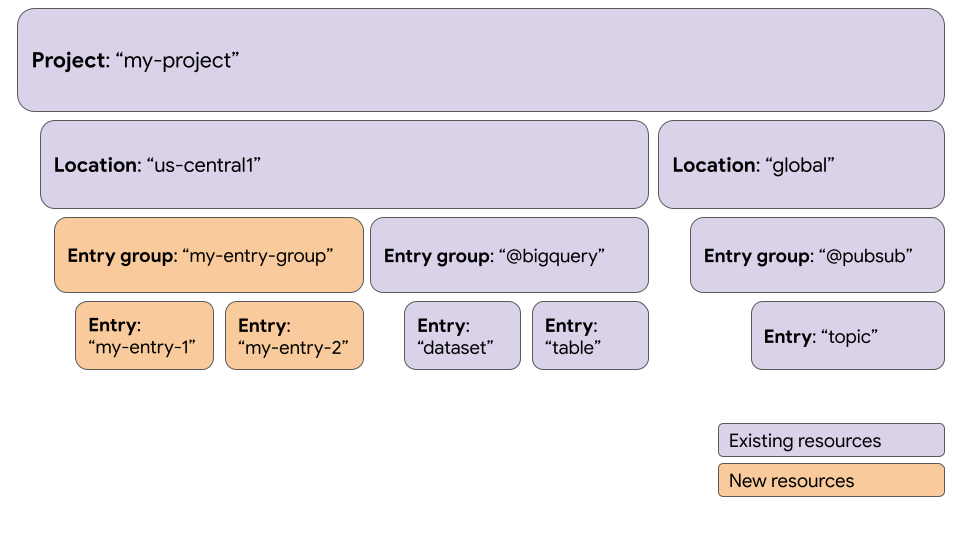Entries and entry groups are key concepts in Data Catalog.
The following illustration depicts how entries and entry groups fit in the Data Catalog data model.

Entries
Data Catalog entries represent data resources:
- Google Cloud resources, such as a BigQuery dataset or table, Pub/Sub topic, for example.
- Custom resources with custom data types.
You can create, search, and manage your entries. For more information, see Create custom Data Catalog entries for your data sources.
Entry groups
Entries are contained in an entry group. An entry group is a set of logically related entries together with Identity and Access Management policies that specify the users who can create, edit, and view entries within an entry group.
Data Catalog automatically creates entry groups for Google Cloud
resources, such as BigQuery (@bigquery) and Pub/Sub
topics (@pubsub).
The BigQuery and Pub/Sub entry groups are unique because you cannot run API functions that typically work on custom entry groups. Some examples of such functions are retrieving the list of entry groups in a project, retrieving basic information about an entry group, and creating or deleting a tag.
You can create your own entry group to contain your Cloud Storage fileset entries and the IAM policies associated with those entries. For more information, see Surface files from Cloud Storage with fileset entries.
Entry groups, similar to entries, are searchable.
Map data assets to entries and entry groups
Refer to the following tables to see how Data Catalog maps data assets from different Google Cloud products.
| Dataproc Metastore resource | Data Catalog resource |
|---|---|
| Service | Entry and entry group |
| Database | Entry |
| Table | Entry |
| Dataplex Universal Catalog resource | Data Catalog resource |
|---|---|
| Lake | Entry and entry group |
| Zone | Entry |
| Table | Entry |
| Fileset | Entry |
| Pub/Sub resource | Data Catalog resource |
|---|---|
| Topic | Entry inside a Pub/Sub entry group |
| Bigtable resource | Data Catalog resource |
|---|---|
| Instance | Entry and entry group |
| Cluster | Attribute inside an instance entry |
| Table | Entry inside instance entry group |
| Column families | Attribute inside a table entry |
| BigQuery resource | Data Catalog resource |
|---|---|
| Dataset | Entry inside a BigQuery entry group |
| Linked dataset | Entry inside a BigQuery entry group |
| Table | Entry inside a BigQuery entry group |
| View | Entry inside a BigQuery entry group |
| Model | Entry inside a BigQuery entry group |
| Routine | Entry inside a BigQuery entry group |
| Connection | Entry inside a BigQuery entry group |
| Vertex AI resource | Data Catalog resource |
|---|---|
| Model | Entry inside a Vertex AI entry group |
| Dataset | Entry inside a Vertex AI entry group |
| FeatureGroup | Entry inside a Vertex AI entry group |
| FeatureOnlineStore | Entry inside a Vertex AI entry group |
| FeatureView | Entry inside a Vertex AI entry group |
